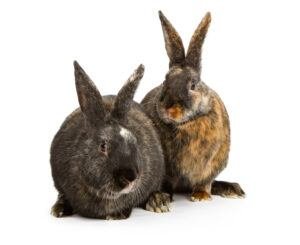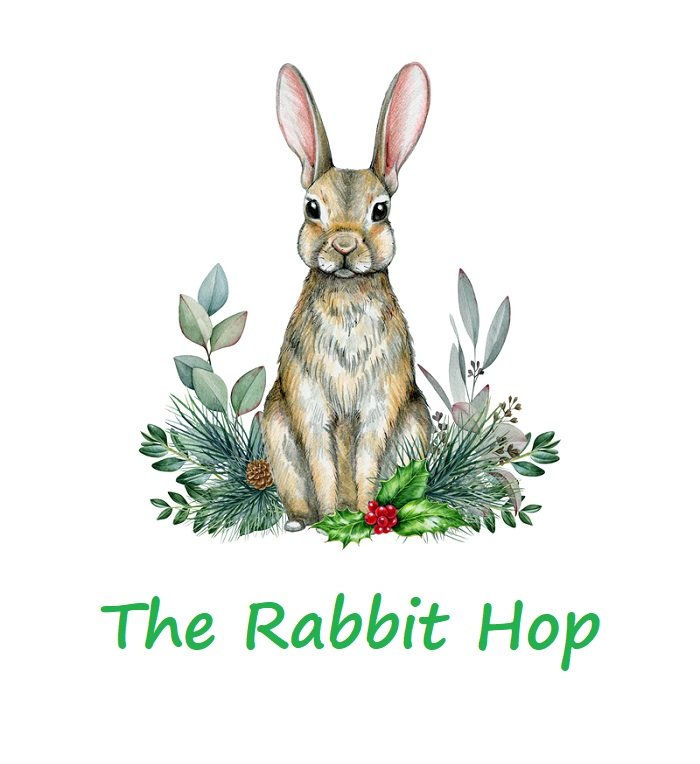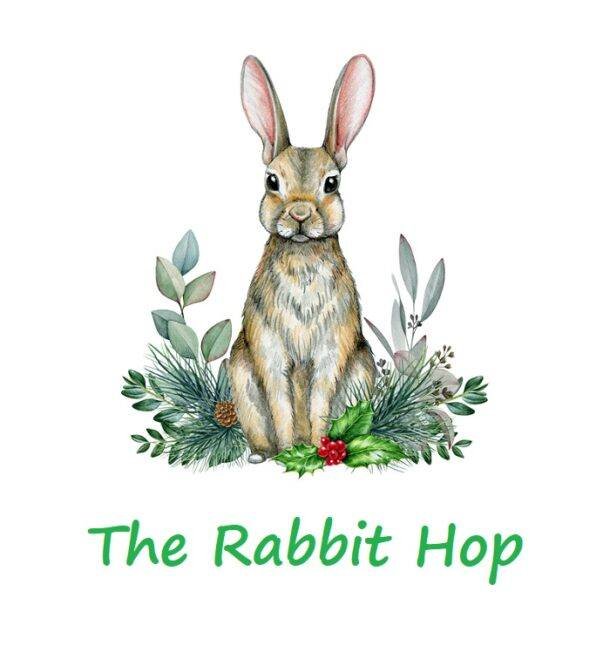Harlequin rabbits are famous because of their unique markings and clown-like personalities. They are known to be outgoing, playful, and friendly. These bunnies are also not aggressive, and their coats are easy to groom. This blog post will help you to know if a Harlequin rabbit breed is the perfect companion for you!

Harlequin rabbits
Facts about Harlequin Rabbits
| Body Size | Medium to large |
| Body Weight | 6.5 lbs to 9.5 lbs |
| Body Shape | Commercial |
| Lifespan | 5 to 8 years |
| Colors | Orange or white fur combined with chocolate, lilac, blue, or black |
| Rarity | Rare |
| Similar Breeds | Dutch rabbit |
| Best Suited for | First-time rabbit owners, families with children |
| Origin | France |
Background and History
The Harlequin rabbits are colorful breeds that originated in France during the 1880s. They were offspring of the semi-wild Tortoiseshell Dutch rabbits and wild rabbits. At first, they were called Japanese rabbits because of their distinctive markings. But after World War II, the name was changed to the Harlequin rabbit.
These adorable bunnies were first exhibited in 1887 in Paris in the Jarin D’Acclimation. After a few years, the rabbits were brought to England, where they gained popularity. However, the breed took 10 to 15 years to arrive in Germany. At first, they were unpopular, disappearing for a moment. But now, it has become a recognized breed in Germany.
During the 1920s, the Harlequin rabbit breed arrived in the United States. Although some argued that this bunny is a variety, not a breed, ARBA acknowledged it. However, its popularity would drop and rise. It led the ARBA to list and delist the bunny a few times in the official breed roster. But these bunnies became famous for rabbit shows and household companions.
Unfortunately, they are one of the rare breeds today. Currently, two varieties of Harlequins are recognized: the Japanese and Magpie. These bunnies are called the “Royal Jesters” and “Clown of the Rabbits”.
Features of Harlequin Rabbits
Harlequin rabbits have the commercial body type that can reach 6.5 lbs to 9.5 lbs. Does are heavier compared to bucks since they can weigh between 7 lbs to 9.5 lbs. On the other hand, bucks can be between 6.5 lbs and 9 lbs. Their round heads and medium-boned bodies are well-proportioned. Meanwhile, their hindquarters are slightly wider than their shoulders. They also have medium-length ears that stand upright in their heads.
Although their flyback coats are dense, they are short and soft, so grooming them is pretty. Show quality Harlequins must have at least five to seven body markings. The marking could be either bar, a band, or a combination. The ideal bunny should have two colors evenly split on its head, ears, body, and feet.
ARBA’s Standard of Perfection qualifies Harlequins with at least three-part frontal alteration. They must have different colors on their faces and alternating shades on their ears. The colors of the face must be split down the center, resembling the court jesters in the Middle Ages. The color of their feet must also alternate with the ears. Bellies should be white or orange.
As mentioned, there are two types of Harlequins. Japanese Harlequins have orange fur with lilac, blue, black, or chocolate. The only difference is that Magpie Harlequins have white fur instead of orange.
Temperament and Behavior
A Harlequin rabbit breed does not only look like a clown but also acts like one. It is known to be outgoing, playful, and good-natured. Thus, it is an ideal pet for first-time owners and families with children. Many owners love this breed because it is rarely aggressive. Instead of biting or scratching, this adorable pet chooses to run if frightened.
As an inquisitive bunny, it will hop around the room frequently to explore every inch of it. It is advisable to keep your eye on this curious bunny since it can easily escape if unsupervised. You can also train this breed because it is intelligent and quickly trusts its owners. Some tricks you can teach are potty training and helping your rabbit recognize its name.
Affectionate and friendly, Harlequin rabbits love to be petted and cuddled occasionally. They also get along quickly with children due to their playfulness. However, supervise your kids when handling them. It would also be better to get rabbit companions since these bunnies may feel lonely if left alone.
Grooming Harlequin Rabbits
Despite the short furs of the Harlequin rabbits, you must still groom them. Brush them at least twice a week using a wire-bristled brush. Brush the coats from the direction of the hair growth going to the tip. If there is any matting, it is recommended to use a wide comb.
As a warning, never bathe your bunny. Aside from causing stress or other health issues to your pet, it removes the natural oil on the bunny’s coat. Thus, it will look ragged and rough. If there are any dirty spots, especially its bottom, you can wipe them with a damp cloth. For coat stains, white alcohol or peroxide can remove them.
Clipping the rabbit’s toenails can be challenging at first. But once you get used to it, it becomes an easy routine. If you think it will be a disaster, you can let a vet or a groomer do the work. But if you want to do it, make sure you are calm and confident. Your bunny may sense your fear, making it jumpy and nervous.
To prevent your pet from slipping, place a towel on your legs before placing your bunny between your legs. Cutting white nails are easier compared to darker one. It is because you can determine where the “quick” is. Simply avoid the pink center. You should never cut dark nails too short since the toes may bleed.
Proper Diet
The amount of food given to a Harlequin rabbit breed will depend on age, size, and activity level. But like other rabbit breeds, its diet must consist of 70% to 80% hay. For young bunnies, the most recommended hay is alfalfa. But as they grow older, you must slowly transfer them into timothy hay. There are also other types of hay that you can select.
Fresh food must also be at least 10% of your bunny’s diet. Aside from being nutritious, they provide moisture and bring various tastes and textures. 75% of fresh food must be leafy greens, 15% non-leafy greens, and 10% fruits. However, there are fresh foods that you must not give to your rabbit.
Limit giving veggies from the cabbage family since they may cause painful gas. Examples of these are cabbage, cauliflower, and garden cress. Also, prevent feeding it with veggies high in calcium, like turnip greens and kale. They may lead to kidney stones if given too much.
You must also prevent feeding them veggies that are high in starch. Fresh foods you should never give your rabbit include kidney beans, onions, and dried peas. Other toxic foods for your pet are tea leaves, nuts, grains, and potatoes.
Habitat

Rabbit exploring outdoors
Since Harlequin rabbits are medium to large bunnies, you must provide them with a large cage. It must be big enough for your bunny to hop three to four times in one direction. A medium-sized bunny like a Harlequin can cover at least 45 cm in one hop. For the width, the size must be between 60 cm to 90 cm.
Ensure the hutch is sturdy enough so your bunny won’t easily break it. Also, it will be safe from predators and strong winds. Rabbits are vulnerable to extreme temperatures. Thus, you must place the cage under the shade. It must also be quiet since bunnies are easily frightened by loud noises.
If you want to keep your pet indoors, it would be better to train it to use the litter box. Aside from that, you have to make your house rabbit-proof. It will surely chew the wires and valuables as a curious breed. You must also keep it away from household pets, like dogs and cats.
Health Issues of Harlequin Rabbits
Flystrike
A Harlequin rabbit breed is susceptible to common health issues like flystrike. It is a condition wherein flies lay eggs on the rabbit’s damp skin. Once the eggs hatch, the maggots feed on the bunny’s flesh. It is a severe condition that requires immediate medical attention.
Signs of flystrike include lethargy, loss of appetite, and fur loss. You may also notice wounds that have maggots and a foul smell coming from your bunny. Because of pain, the rabbit may suddenly collapse and lose consciousness. If this happens, don’t hesitate to go to the vet for treatment.
The vet has to sedate or anesthetize the bunny to remove the maggots. He will also have to clean and debride dead and infected issues. Your bunny may undergo surgery to remove all the infected tissues for severe cases. After the treatment, your pet cannot go outdoors for at least a month.
Ear mites
Ear mites are a condition usually caused by the parasite Psoroptes cuniculiis. These mites may transmit from one rabbit to another. Or they may invade a bunny due to the exposure in their eggs through bedding materials. If ignored, it may cause infection in the rabbit’s ears leading to hearing loss.
Some of the symptoms of ear mites you must watch for are itching around the ear and head and frequent head shaking. You may also notice hair loss and lesions in the area. Your bunny may also show signs of excruciating pain. Vets treat ear mites by prescribing ivermectin and oral antibiotics.
Frequently Asked Questions
Are Harlequin rabbits hard to keep as pets?
Because of their temperaments, Harlequin rabbits are relatively easy to keep as pets. They are not aggressive and highly sociable, especially with their owners. These bunnies also love to be cuddled and petted occasionally. They also get along quickly with kids. But you have to supervise your children when handling these bunnies.
How much does a Harlequin rabbit breed cost?
A Harlequin rabbit breed may cost between $20 to $100. A show-quality Harlequin is more costly compared to household pets. The price may also depend on the colors of the coats and the quality of the markings.
Conclusion
Harlequin rabbits don’t only have remarkable features. But they also have wonderful personalities. Since they are good-natured, they are ideal pets for most kinds of owners. But like any other rabbit breed, you must give them enough attention. Thus, they may enjoy their lives living with you.
Read More
‘
American Rabbits: Bunnies with Blue Coats
Tan Rabbits: Aristocrats of the Fancy


